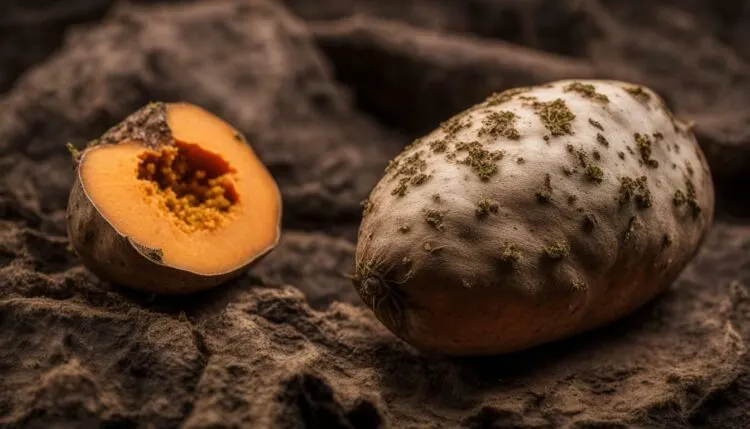Sweet potatoes are a popular and nutritious vegetable, but what happens when they become pithy? Pithiness refers to the presence of woody or fibrous tissue in the sweet potato, making it less desirable for consumption. The question is, are pithy sweet potatoes safe to eat?
Pithy sweet potatoes, characterized by holes and cavities, are safe to eat. These irregularities, often due to fluctuating soil moisture, result in a slightly altered texture and taste. Though less sweet than uniform ones, their nutritional value remains unaffected.
In this article, we’ll explore how to identify pithiness and determine if it’s safe to eat pithy sweet potatoes.
Key Takeaways:
- Pithiness refers to the presence of woody or fibrous tissue in sweet potatoes.
- Identifying visual signs of pithiness, such as dark spots, black spots, small holes, white spots, and soft spots.
- Determining the safety of pithy sweet potatoes by evaluating signs of spoilage and the condition of the rest of the sweet potato.
- Proper storage guidelines for sweet potatoes to maintain their freshness and extend shelf life.
- Sweet potatoes offer high nutritional value, particularly in vitamin C content.

Identifying Pithy Sweet Potatoes
When it comes to checking the safety of sweet potatoes, visual inspection is key. By learning how to identify pithiness, you can determine whether the sweet potatoes are fit for consumption.
| Visual Signs of Pithiness: |
|---|
| Dark spots: These are often the first sign of pithiness and can be found anywhere on the sweet potato. |
| Black spots: Similar to dark spots, black spots are an indication of pithiness and should be avoided. |
| Small holes: These can be a sign of insect damage, which can lead to pithiness. |
| White spots: These can indicate mold, which can also cause pithiness. |
| Soft spots: When pressed, pithy sweet potatoes will have soft spots that give way easily. These soft spots can also be an indication of rot. |
If you come across any of these signs, it’s best to avoid eating the sweet potato altogether to prevent any potential health risks.
Now that you know how to identify pithiness in sweet potatoes, let’s discuss how to determine their safety for consumption. Signs of spoilage in sweet potatoes include bad spots, moldy areas, and soft spots. If you see any of these signs, it may indicate that the sweet potato is no longer safe to eat.
When checking for spoilage, it’s important to inspect the entire sweet potato, not just the affected area. If the rest of the sweet potato appears healthy, it may still be safe to eat after trimming off the bad spots. However, if the sweet potato appears to be in overall poor condition, it’s best to discard it to avoid any potential health risks.
If you’re unsure about the safety of a sweet potato, it’s always better to err on the side of caution and discard it.

Proper Storage for Sweet Potatoes
Proper storage of sweet potatoes is crucial for their longevity and optimal quality. To ensure they stay fresh, store sweet potatoes at room temperature in a dark place, away from direct sunlight or heat sources.
Storing sweet potatoes in a warm location can cause them to sprout or spoil quickly, while keeping them in the refrigerator can result in a hard and unappetizing texture. Instead, choose a cool and dark spot in your pantry or kitchen.
For longer shelf life, consider placing sweet potatoes in an airtight container or a plastic bag with small perforations to prevent moisture buildup. This will help prevent mold and extend their freshness for up to several weeks.
| Do: | Store sweet potatoes at room temperature |
|---|---|
| Choose a cool, dark place away from direct sunlight or heat | |
| Use an airtight container or plastic bag with small perforations | |
| Don’t: | Store sweet potatoes in the refrigerator |
| Store sweet potatoes in a warm location |
By following these guidelines, you can enjoy fresh and delicious sweet potatoes for longer periods while maintaining their nutritional value.

Sweet potatoes are not only delicious but also packed with essential nutrients that provide numerous health benefits. One medium sweet potato contains about 120 calories and is an excellent source of vitamins and minerals.
The most notable of these is vitamin C, which is essential for a healthy immune system. One medium sweet potato contains about 40% of the daily recommended intake of vitamin C, making it one of the best dietary sources of this essential vitamin.
In addition to vitamin C, sweet potatoes also contain high levels of vitamin A, which is essential for good vision, healthy skin, and strong bones. They’re also rich in potassium, an essential mineral that helps regulate blood pressure and keeps the heart healthy.
Moreover, sweet potatoes are a good source of fiber, which plays a crucial role in maintaining healthy digestion. Fiber is also known to reduce the risk of heart disease and some types of cancer.
Finally, sweet potatoes are low in fat and contain no cholesterol, making them an excellent food choice for individuals who are looking to maintain a healthy weight and reduce their risk of heart disease.

“Sweet potatoes are an excellent choice for individuals who are looking to maintain a healthy weight and reduce their risk of heart disease.”
Conclusion
Despite their potential for pithiness, sweet potatoes are generally safe to eat as long as you take the necessary precautions. By identifying visual signs of spoilage, such as dark spots, black spots, small holes, white spots, or soft spots, you can determine whether a sweet potato is still suitable for consumption. If you notice any moldy areas, or if the rest of the potato looks bad, it’s best to discard it.
It’s also important to store sweet potatoes properly to increase their shelf life. Keep them at room temperature in a dark place, and consider using an airtight container or a plastic bag to maintain their freshness. By doing so, you can enjoy sweet potatoes’ numerous health benefits, including their high vitamin C content.
Overall, pithy sweet potatoes can be safe to eat when you know what to look for and how to store them properly. So go ahead and add sweet potatoes to your next meal knowing you’re making a healthy and safe choice!
FAQ
How can I identify pithy sweet potatoes?
Pithy sweet potatoes can be identified by visual signs such as dark spots, black spots, small holes, white spots, and soft spots. These indicators can suggest that the sweet potatoes have become pithy and may not be suitable for consumption.
How do I determine the safety of pithy sweet potatoes?
To determine the safety of pithy sweet potatoes, you should inspect for signs of spoilage. Look for any moldy areas or check the condition of the rest of the sweet potato. If there are no evident signs of spoilage, the sweet potato should be safe to eat.
What is the proper storage method for sweet potatoes?
Sweet potatoes should be stored at room temperature in a dark place to maintain their quality. It is recommended to store them in an airtight container or a plastic bag to extend their shelf life and keep them fresh for longer.
What is the nutritional value of sweet potatoes?
Sweet potatoes are highly nutritious and packed with vitamins, especially vitamin C. They offer various health benefits and are a great addition to a balanced diet.
Can pithy sweet potatoes still be nutritious?
While pithy sweet potatoes may not be ideal in terms of texture, they can still retain their nutritional value. However, it is best to consume sweet potatoes that are firm and free from pithiness for the best taste and texture.
- Crescent Roll Origins: Which Country Created It? - February 21, 2024
- What is the Origin of the Name Crescent Rolls? - February 21, 2024
- Are Pillsbury Crescent Rolls a Good Substitute for Puff Pastry? - February 21, 2024
